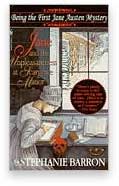It’s new to me: Jane and the Unpleasantness at Scargrave Manor review
 I usually claim in my retro reviews how it’s inexplicable that I haven’t gotten around to reading this or that, but in the case of Jane and the Unpleasantness at Scargrave Manor by Stephanie Barron, the truth is that I’ve been reluctant to read other Jane Austen-themed mysteries because of my own poor efforts at the genre.
I usually claim in my retro reviews how it’s inexplicable that I haven’t gotten around to reading this or that, but in the case of Jane and the Unpleasantness at Scargrave Manor by Stephanie Barron, the truth is that I’ve been reluctant to read other Jane Austen-themed mysteries because of my own poor efforts at the genre.
But of late it’s been embarrassing to say that I haven’t read Ms. Barron’s stories where Jane Austen acts as the detective, in this case attempting to clear the name of her friend Isobel, the newly married Countess of Scargrave, accused of the death of her husband. And then she must also take on the task of defending Fitzroy Payne, the new Earl of Scargrave, after he is accused of murdering Isobel’s accuser.
Jane had been invited by her friend to the ball the soon to be dead Earl of Scargrave is throwing in Isobel’s honor. He dies a pretty horrific death that is at first attributed to his overindulgence of the good life but is later suspected to be poison. At her friend’s pleading, Jane remains to give Isobel moral support. The book is supposedly taken from Jane’s diary entries, and includes letters to her sister Cassandra. The book takes place after her father has retired and moved the family, much to Jane’s displeasure, to Bath. Other characters include Isobel’s aunt Madame Delahoussaye and her daughter Fanny, and Isobel’s maid Marguerite. All four women hail from Barbados, where Isobel’s family estates are coveted by the insidious Lord Trowbridge (a boo and hiss are called for here), who is inexplicably also a guest at the ball. Oh, and then there’s the scapegrace (love that word) Lt. Tom Hearst (killed a man just for snoring … err, for accusing him of cheating at cards) and his sanctimonious brother George, who are cousins of the new earl. This stew of characters is made all the more savory by the denied love between the new earl and the old earl’s wife.
And these are just the main characters, with little cameos from Austen brothers Francis and Henry, and Henry’s wife Eliza, or more formally the Comtess de Feuillide. In truth, there may be a few too many characters, but don’t worry, there is a little thinning as in an Agatha Christie story, where suspects conveniently die. Oh, and did I mention the ghost of the first Earl of Scargrave, who appears early in the book and waits until the concluding chapters to reappear?
I enjoyed the book but I can’t call it a page turner, and I think that left me with mixed emotions. The book title proudly proclaims it as “Being the first Jane Austen mystery,” so I naturally started reading it as a mystery and expected the pacing of the aforementioned Christie instead of the ruminative pacing of Austen. But Austen doesn’t really strike one as a great detective, despite showing some real Sherlockian powers of deduction early on. Her powers of deduction don’t come to her as easily as they do to Poirot, Miss Marple or Sherlock Holmes. In fact, she is as often surprised by the twists and turns of the case as is presumably the reader.
In the end, I think Ms. Barron’s decision to not make Jane Austen a super sleuth a wise one. We think we know Jane and consider her perceptive and insightful but, I doubt we’ve ever thought of her as a detective. Instead in Ms. Barron’s novel, Jane Austen shines as a very bright woman who is devotedly loyal to her friends and who will do the best she can to help them. That characterization rings true and I think makes a better book than if Jane were to go around with a magnifying lens.
And now that I’ve had my first taste of “the first Jane Austen mystery,” I am ready to read the next story, which I believe is “Jane and the Man of the Cloth.”
